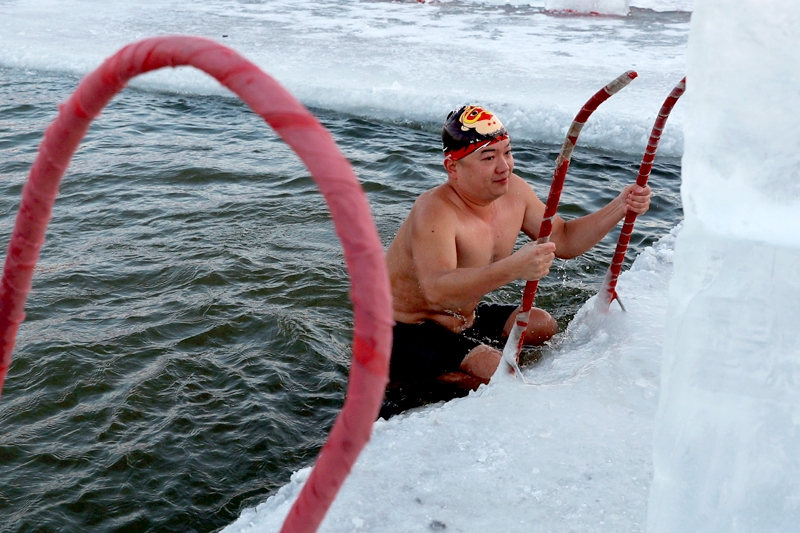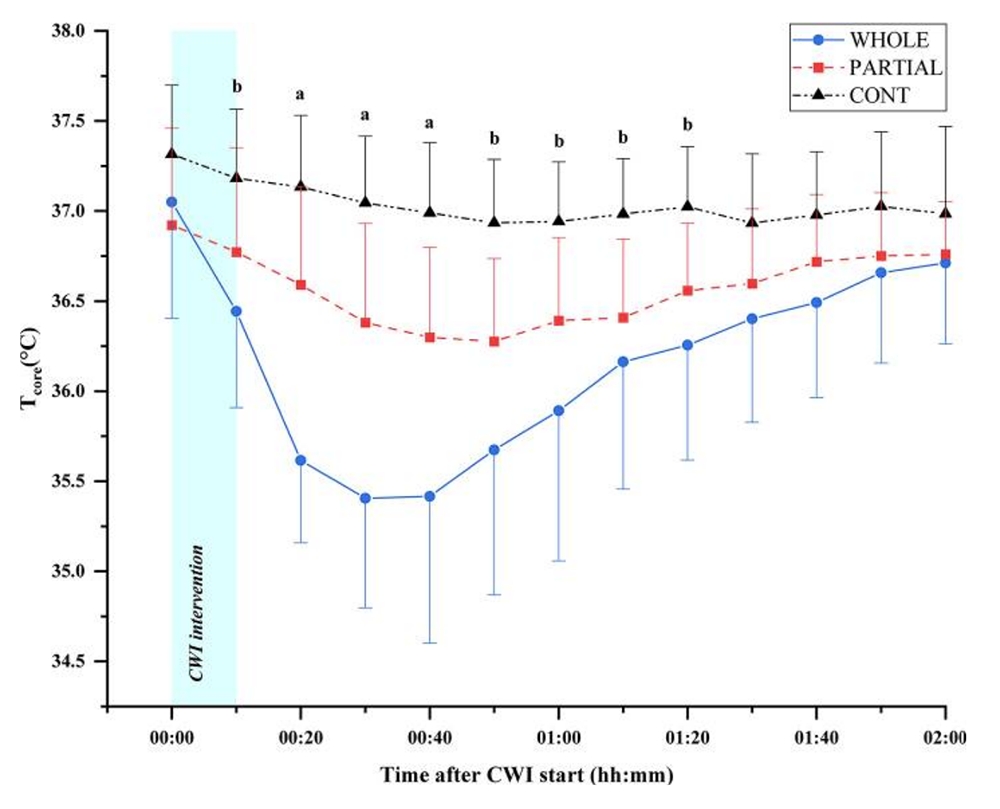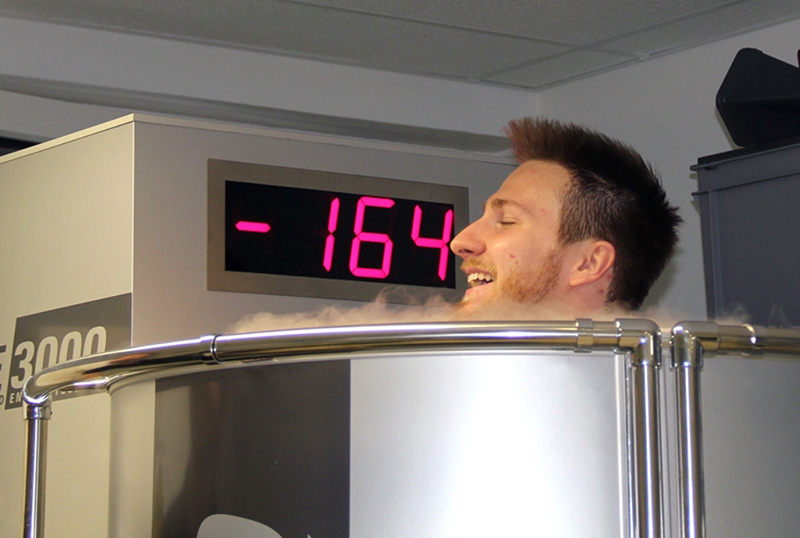You are viewing 1 of your 1 free articles. For unlimited access take a risk-free trial
Cool it: does total cold water immersion improve recovery?

SPB looks at new research on the use of cold water immersion for boosting recovery and sleep quality
At high levels of sport, athletes engage in regular competition, and often train multiple times a day for consecutive days. These demands can make it very difficult for athletes to recover optimally, which is bad for performance since the faster and more fully an athlete can recover, the sooner he or she will be refreshed and physiologically ready to train and/or compete again. As we have discussed in other SPB articles, optimum recovery involves adequate rest, plentiful sleep and of course good nutrition. However, other therapeutic strategies also exist, one of which is ‘cold water immersion’ or CWI for short. The use of CWI involves the athlete immersing themselves for a period of time in cold water (typically around 10-13C [50-55F]) right after training or competition. Compared to other therapeutics such as foam rolling, stretching, massage etc, the use of CWI for accelerating recovery has demonstrated the highest scientific level of evidence.Why does CWI aid recovery?
CWI after exercise decreases the body’s core temperature – not just back to its normal baseline level but to below its baseline level, with a peak drop in core temperature occurring around an hour following immersion. This cooling effect has been shown to help repair exercise-induced muscle damage, with a larger effect for weight-bearing (running and strength training) compared with non-weight-bearing activities(2,3). Scientists believe that the enhanced repair effect is likely to be related to CWI-induced muscle cooling and direct hydrostatic pressure – ie the pressure of water acting directly on the muscles(4). In terms of what this means for athletes, the key benefits of CWI are reductions in delayed onset muscle soreness, edema, and exercise-induced strength loss. In addition, subjective measures of fatigue and recovery are typically improved in the hours and days following CWI(5).What kind of CWI works best?
There are a number of variations of the use of cold therapy. One is the use of much colder temperatures – aka ‘cryotherapy’ (see this article for a comparison of cryotherapy vs. CWI). The length of CWI time is also a factor. Something else that may be important is the extent of immersion. In particular, there’s evidence that the effectiveness of CWI may be higher when the whole body (including head) is immersed compared with a partial-body protocol where the legs, part of the torso and arms are immersed(6). Why would total immersion, including the head, be more effective than partial immersion? Well, the immersion of the head seems especially important to induce a maximal rate of decline in core temperature, speeding up the temperature drop by up to 42%(7). There’s also good evidence that this enhanced drop in core temperature can aid sleep onset and quality, especially if CWI is performed close to bedtime(8). Given the importance of sleep in recovery (see this article), this could be another bonus for total immersion.New research
To date, no study has assessed the effect of whole-body CWI (ie head also immersed) on sleep and recovery in a sport setting. However, a newly-published study in the journal Frontiers in Sport and Active Living has investigated the effects of the depth of CWI (whole-body with head immersed vs. partial-body CWI) on recovery and sleep (when performed close to bedtime) after high-intensity, intermittent running in well-trained runners(9).In this study, 12 well-trained male endurance runners with high levels of aerobic fitness performed a simulated trail run on a treadmill on three separate occasions, each at around 6pm. The simulated trail run lasted 48 minutes with five 9-minute blocks – enough to produce a significant level of fatigue and muscle damage until 48 hours after exercise. Each block included 4 minutes of downhill running (−12.5% gradient) followed by 3 minutes of flat running (0% gradient) and 2 minutes of uphill running (+10% gradient). The three simulated runs were all identical except for the recovery protocol immediately after the treadmill run:
- Whole body CWI (including head) for ten minutes in water at 13.3C (55F).
- Partial body immersion (up to waist level) for the same time and water temperature.
- Control condition in which no CWI took place after the run.
The findings
The main findings were as follows:- The whole body immersion induced a significantly lower core temperature for 80 minutes after the immersion – an effect not significantly seen with the partial immersion (see figure 1).
- Slow-wave sleep (the deepest sleep and which is most important for recovery) proportions were higher during the first three hours of the night’s sleep in whole immersion compared to partial immersion.
- Both whole and partial immersion reduced arousal, during the sleep period but only the whole immersion significantly reduced limb movements and restlessness.
- Both whole and partial immersions largely improved the subjective measure of ‘feeling refreshed in the morning’ compared to the control condition.
- No differences between conditions were observed for any markers of soreness or muscle damage throughout the 48-hour recovery period.
Figure 1: Core temperature changes over time following whole, partial and no immersion conditions(9)

Note the very large and steep decline in core temperature following total immersion.
What do these findings mean for athletes?
This study showed that both whole and partial CWI performed after a high-intensity, intermittent running task significantly decreased sleep arousals in the crucial phase of slow-wave sleep, but that the whole body immersion was more effective in this respect. The most likely explanation for this is that the whole body immersion resulted in a larger drop in core temperature, which was sustained for longer after exercise. Given these immersions took place in the evening, it’s likely that there remained a beneficial effect at bedtime – as evidence by the improvement in slow wave sleep proportions.Given that we know athletes can suffer from disturbed sleep and restlessness during periods of unusually high-intensity training or competition(10), these findings suggest that cold water immersion at the end of the day may be of particular benefit to athletes, especially if the immersion is total.
Interestingly however, neither full nor partial immersion appeared to improve other measures of muscle damage such as soreness or creatine kinase, suggesting (in contrast to some other studies) that the benefits of cold water immersion to athletes might arise more from improved sleep quality than direct physiological changes to the muscles. However, given the influence of sleep and in particular the brain/central nervous system in determining performance (the so-called ‘central governor theory’ - see this article), perhaps we should not be surprised. Was there any extra significance of cooling the head beyond a greater drop in core temperature? We don’t have an answer to that at the moment; studies will be needed to investigate head-only cooling after exercise to see if it plays a unique role in improving sleep/recovery following high-intensity exercise. But when that research comes along, we’ll be first to report it!
Tips for using CWI
- Immerse the body for around ten minutes immediately or as soon as possible after training
- Use a water temperature of around 10-13C. In the summer, this may involve additional cooling of the water with some ice.
- Try to immerse as much of the body as possible. If you have a large enough bath or outdoors facility, you can try immersing the head also!
- Evening CWI may be better for improving sleep than earlier sessions. However, ensure that any CWI protocol doesn’t interfere with your normal preparations for bedtime – ie don’t perform it right before retiring.
- Save CWI for use after particularly hard training sessions; there’s little benefit to be had after easy-moderate training.
- Sports Med. 2013 Jan; 43(1):9-22
- Sports Med. 2016 Aug; 46(8):1095-109
- Int J Sports Physiol Perform. 2011 Jun; 6(2):147-59
- Br J Sports Med. 2012 Mar; 46(4):233-40
- Int J Sports Physiol Perform. 2008 Sep; 3(3):331-46
- Sports Med. 2006; 36(9):747-65
- J Appl Physiol (1985). 2006 Aug; 101(2):669-75
- Sport Sci. 2019 Health 15, 223–228.
- Front Sports Act Living. 2021; 3: 659990
- Sports Med. 2017 Jul; 47(7):1317-1333
Newsletter Sign Up
Testimonials
Dr. Alexandra Fandetti-Robin, Back & Body Chiropractic
Elspeth Cowell MSCh DpodM SRCh HCPC reg
William Hunter, Nuffield Health
Newsletter Sign Up
Coaches Testimonials
Dr. Alexandra Fandetti-Robin, Back & Body Chiropractic
Elspeth Cowell MSCh DpodM SRCh HCPC reg
William Hunter, Nuffield Health
Keep up with latest sports science research and apply it to maximize performance
Today you have the chance to join a group of athletes, and sports coaches/trainers who all have something special in common...
They use the latest research to improve performance for themselves and their clients - both athletes and sports teams - with help from global specialists in the fields of sports science, sports medicine and sports psychology.
They do this by reading Sports Performance Bulletin, an easy-to-digest but serious-minded journal dedicated to high performance sports. SPB offers a wealth of information and insight into the latest research, in an easily-accessible and understood format, along with a wealth of practical recommendations.
*includes 3 coaching manuals
Get Inspired
All the latest techniques and approaches
Sports Performance Bulletin helps dedicated endurance athletes improve their performance. Sense-checking the latest sports science research, and sourcing evidence and case studies to support findings, Sports Performance Bulletin turns proven insights into easily digestible practical advice. Supporting athletes, coaches and professionals who wish to ensure their guidance and programmes are kept right up to date and based on credible science.











